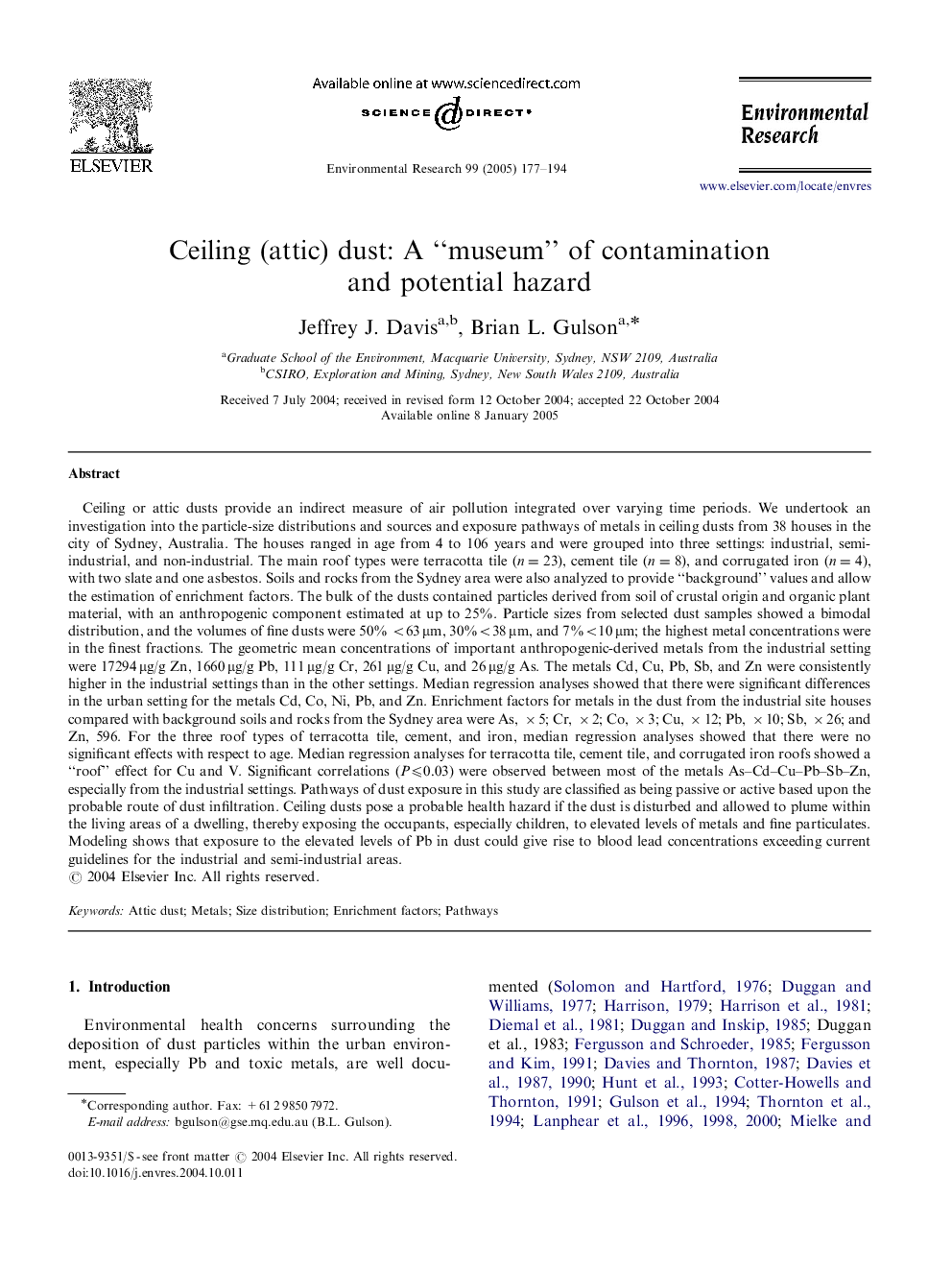| کد مقاله | کد نشریه | سال انتشار | مقاله انگلیسی | نسخه تمام متن |
|---|---|---|---|---|
| 9464699 | 1314486 | 2005 | 18 صفحه PDF | دانلود رایگان |
عنوان انگلیسی مقاله ISI
Ceiling (attic) dust: A “museum” of contamination and potential hazard
دانلود مقاله + سفارش ترجمه
دانلود مقاله ISI انگلیسی
رایگان برای ایرانیان
کلمات کلیدی
موضوعات مرتبط
علوم زیستی و بیوفناوری
علوم محیط زیست
بهداشت، سم شناسی و جهش زایی
پیش نمایش صفحه اول مقاله

چکیده انگلیسی
Ceiling or attic dusts provide an indirect measure of air pollution integrated over varying time periods. We undertook an investigation into the particle-size distributions and sources and exposure pathways of metals in ceiling dusts from 38 houses in the city of Sydney, Australia. The houses ranged in age from 4 to 106 years and were grouped into three settings: industrial, semi-industrial, and non-industrial. The main roof types were terracotta tile (n=23), cement tile (n=8), and corrugated iron (n=4), with two slate and one asbestos. Soils and rocks from the Sydney area were also analyzed to provide “background” values and allow the estimation of enrichment factors. The bulk of the dusts contained particles derived from soil of crustal origin and organic plant material, with an anthropogenic component estimated at up to 25%. Particle sizes from selected dust samples showed a bimodal distribution, and the volumes of fine dusts were 50% <63 μm, 30%<38 μm, and 7%<10 μm; the highest metal concentrations were in the finest fractions. The geometric mean concentrations of important anthropogenic-derived metals from the industrial setting were 17294 μg/g Zn, 1660 μg/g Pb, 111 μg/g Cr, 261 μg/g Cu, and 26 μg/g As. The metals Cd, Cu, Pb, Sb, and Zn were consistently higher in the industrial settings than in the other settings. Median regression analyses showed that there were significant differences in the urban setting for the metals Cd, Co, Ni, Pb, and Zn. Enrichment factors for metals in the dust from the industrial site houses compared with background soils and rocks from the Sydney area were As, Ã5; Cr, Ã2; Co, Ã3; Cu, Ã12; Pb, Ã10; Sb, Ã26; and Zn, 596. For the three roof types of terracotta tile, cement, and iron, median regression analyses showed that there were no significant effects with respect to age. Median regression analyses for terracotta tile, cement tile, and corrugated iron roofs showed a “roof” effect for Cu and V. Significant correlations (P⩽0.03) were observed between most of the metals As-Cd-Cu-Pb-Sb-Zn, especially from the industrial settings. Pathways of dust exposure in this study are classified as being passive or active based upon the probable route of dust infiltration. Ceiling dusts pose a probable health hazard if the dust is disturbed and allowed to plume within the living areas of a dwelling, thereby exposing the occupants, especially children, to elevated levels of metals and fine particulates. Modeling shows that exposure to the elevated levels of Pb in dust could give rise to blood lead concentrations exceeding current guidelines for the industrial and semi-industrial areas.
ناشر
Database: Elsevier - ScienceDirect (ساینس دایرکت)
Journal: Environmental Research - Volume 99, Issue 2, October 2005, Pages 177-194
Journal: Environmental Research - Volume 99, Issue 2, October 2005, Pages 177-194
نویسندگان
Jeffrey J. Davis, Brian L. Gulson,